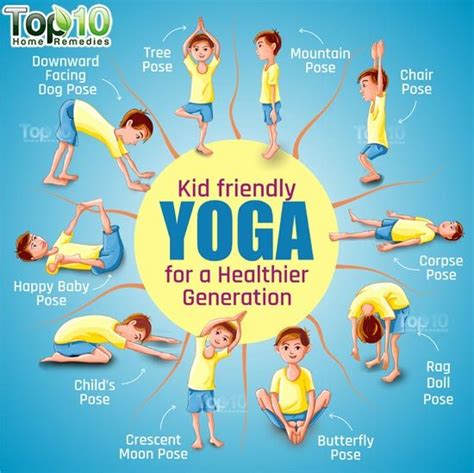Is Yoga Safe for Children? A Comprehensive Guide for Parents and Educators
Yoga has long been praised for its physical, mental, and emotional benefits for adults, but is it equally beneficial—and safe—for children? This guide explores whether yoga can be safely practiced by children, addressing concerns, benefits, misconceptions, and the best practices for introducing kids to this ancient practice. We’ll also offer specific yoga poses that are appropriate for children, along with practical applications, case studies, and insights into the long-term implications of yoga for children’s development.
Introduction
Yoga has become increasingly popular among children, as parents and educators recognize its potential for improving physical flexibility, focus, and emotional well-being. However, there are ongoing debates about its appropriateness for young children, particularly regarding safety, physical readiness, and the spiritual elements often associated with yoga. This article aims to unpack these concerns while providing a comprehensive guide for parents and educators on how to safely and effectively incorporate yoga into a child’s life.
Key Concepts
- Physical Benefits: Yoga can enhance a child’s strength, flexibility, balance, and coordination.
- Mental and Emotional Benefits: It promotes focus, relaxation, emotional regulation, and resilience.
- Safety Concerns: Skeptics worry about the potential for injury, overexertion, or undue pressure on growing bodies.
- Yoga for Children vs. Adults: Children’s yoga typically differs from adult yoga in terms of pace, complexity, and objectives. It is often play-based and focuses on gentle, developmentally appropriate movements.
- Cultural Sensitivities: Some parents and educators express concerns about the spiritual or religious roots of yoga practices.
Historical Context
Yoga, an ancient practice originating in India over 5,000 years ago, has evolved significantly in its Western adaptation. Historically, yoga was a spiritual discipline, but today it is largely secular and focuses on physical and mental well-being. Yoga for children is a relatively modern concept, gaining momentum in the 20th century as part of holistic education and mindfulness movements. The growing popularity of yoga in schools and homes signals a shift toward recognizing its broad benefits for mental health and physical fitness in young people.
Current State Analysis
Today, children’s yoga is widely practiced in schools, studios, and even homes across the world. Some schools integrate yoga as part of their physical education curriculum or as a tool for emotional regulation. However, despite its popularity, there is still considerable debate among parents, educators, and pediatricians about its safety and long-term effects. Concerns about yoga-related injuries, particularly with younger children, highlight the need for proper guidance and instruction.
Research has consistently shown the benefits of yoga for children, especially regarding mental health, concentration, and coping mechanisms for stress. Yet, studies also indicate that without proper supervision and child-specific modifications, injuries such as muscle strain, joint issues, or overexertion can occur. This highlights the importance of trained instructors who understand the unique needs and limitations of children’s bodies.
Practical Applications
When introducing yoga to children, it’s crucial to follow developmentally appropriate practices. Here are a few recommended poses, their benefits, and guidelines for safe practice:
| Pose | Description | Benefits | Safety Tips |
|---|---|---|---|
| Cat-Cow Stretch | Involves arching and rounding the back in a slow, controlled manner. | Improves spine flexibility and coordination. | Avoid hyperextension by keeping movements slow and gentle. |
| Tree Pose | One leg is placed on the opposite thigh or calf, with arms extended overhead. | Enhances balance and concentration. | Ensure the child uses a wall for support if needed to avoid falls. |
| Child’s Pose | A restful pose where the child kneels and stretches their arms forward. | Promotes relaxation and lengthens the back. | Ensure the child doesn’t put pressure on their neck or shoulders. |
| Butterfly Pose | Sitting upright with feet together, knees bent outward. | Opens the hips and improves flexibility. | Encourage gentle stretching without forcing the knees to the ground. |
| Bridge Pose | Lying down, the child lifts their hips while pressing their feet into the floor. | Strengthens the core and improves spinal flexibility. | Make sure the child doesn’t overextend their back; use cushions if needed. |
Case Studies
Case Study 1: Yoga in a Primary School Setting
A primary school in California introduced a 10-minute daily yoga practice in classrooms as part of their morning routine. Within three months, teachers reported improvements in students’ focus, reduced instances of disruptive behavior, and increased overall classroom harmony. The yoga sessions were kept playful and interactive, focusing on simple poses like the Tree Pose and Child’s Pose. However, the school also noted the importance of instructor training, emphasizing that teachers received proper certification to ensure safety and effectiveness.
Case Study 2: Yoga for Children with Special Needs
A yoga program was implemented for children with autism spectrum disorders at a specialized care center. The results showed that yoga helped improve body awareness, reduce anxiety, and enhance social engagement. The yoga sessions were adapted to meet the sensory and emotional needs of the children, ensuring that poses were simple and the environment was calming. However, it was noted that some children were initially resistant, which required the instructor to employ more creative, play-based methods.
Stakeholder Analysis
Introducing yoga to children involves various stakeholders who each have different priorities and concerns. Here’s a breakdown:
| Stakeholder | Concerns | Potential Solutions |
|---|---|---|
| Parents | Safety, religious implications, and long-term benefits. | Provide clear explanations of how yoga can be secular and offer reassurances about age-appropriate modifications to ensure safety. |
| Teachers | Implementing yoga within a crowded curriculum, ensuring all children benefit. | Offer short, simple sessions that focus on relaxation and concentration. Provide proper training to teachers to ensure the yoga is delivered safely and effectively. |
| Pediatricians | Potential physical strain, joint issues, or risk of injury. | Encourage research-backed, child-appropriate yoga routines that avoid excessive strain on joints and muscles. |
Implementation Guidelines
When implementing a yoga program for children, consider the following guidelines to ensure success and safety:
- Start Slow: Introduce yoga in short, playful sessions to gauge children’s interest and ability. Begin with easy, gentle poses.
- Instructor Training: Ensure that instructors are trained specifically in children’s yoga, understanding their physical limitations and emotional needs.
- Parent Involvement: Engage parents by informing them of the benefits, safety precautions, and secular nature of yoga practices.
- Environmental Setup: Use a quiet, calm environment with sufficient space for movement, and provide yoga mats or soft flooring.
- Adaptability: Tailor the yoga sessions to the specific needs of children, especially those with special needs or physical challenges.
Ethical Considerations
While yoga is generally seen as a positive practice, ethical considerations do arise. Parents might be concerned about the cultural or spiritual components of yoga, particularly in secular or religious school settings. It’s important to clearly communicate that modern yoga can be practiced in a non-spiritual, secular manner, focusing purely on physical and mental well-being.
Moreover, the accessibility of yoga should also be considered. All children, regardless of socioeconomic background, should have the opportunity to benefit from yoga. Schools and community centers can make yoga programs more inclusive by offering low-cost or free classes and ensuring that instructors are sensitive to the diverse needs of all children.
Limitations and Future Research
While yoga shows significant promise in benefiting children, there are limitations that require further research. The long-term effects of yoga on children’s development, particularly in relation to physical growth and mental health, are still under-explored. Most existing studies focus on short-term outcomes, and more research is needed to understand the full spectrum of yoga’s benefits and potential risks over time.
Additionally, while anecdotal evidence supports the mental health benefits of yoga, more rigorous, large-scale studies are needed to quantify these effects. Future research should also investigate how yoga can be best adapted for children with physical or cognitive disabilities.
Expert Commentary
Yoga can be a powerful tool for children’s development, but its safe implementation requires careful consideration. With proper guidance, it can foster not only physical flexibility and strength but also emotional resilience and mental clarity. However, the key to success is ensuring that the practice is child-appropriate, with trained instructors, parental engagement, and a clear focus on safety. While the research continues to evolve, current findings suggest that when practiced correctly, yoga offers a multitude of benefits for children, far outweighing the potential risks.








